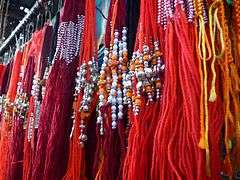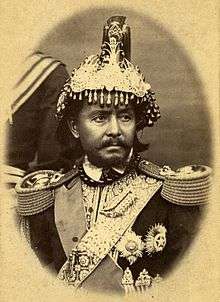Rakhri
| Rakhrhya Punjabi: ਰੱਖੜੀਆ | |
|---|---|
 Examples of Rakhrhya | |
| Official name | Rakhrhya |
| Also called | Rakhar punya |
| Observed by | Hindus, Sikhs, Christians, multicultural |
| Date | ਸਾਵਨ ਪੁੰਨਿਆ |
| 2015 date | Saturday, August 29 |
| 2016 date | Thursday, August 18 |
| 2017 date | Monday, August 7 |
| 2018 date | Sunday, August 26 |
Rakhri or Rakhrhee (Punjabi: ਰੱਖੜੀ) is the Punjabi word for Rakhi. In the Punjab region, the North Indian[1] festival of Raksha Bandhan is celebrated as Rakhrhya (Punjabi: ਰੱਖੜੀਆ). Rakhrhya are celebrated in the lunar month of Sawan on the full moon night,[2] according to the Punjabi calendar which is celebrated by many communities in the Punjab region and is a secular festival.
Meaning
Rakhrhya celebrate the relationship between brothers and sisters. Rakhri means “to protect” whereby a brother promises to look out for his sister and in return, a sister prays for the well being of her brother. A Rakhri can also be tied on a cousin or an unrelated man. If a woman ties a Rakhri on an unrelated man, their relationship is treated as any other brother and sister relationship would be. The festival is also celebrated as a siblings-day[3] comparable to Mother's day/Father's day/Grandparents day etc.
Celebration
Different aspects of Rakhrhya. | |||||
A sister will tie the Rakhri on her brother and her brother will give a gift. Another feature of the celebration is the consumption of sweets.[4] There is no special ceremony but a sister will say something along the lines of:
ਸੂਰਜ ਛੱਡੀਆਂ ਰਿਸ਼ਮਾਂ
ਮੂਲੀ ਛੱਡਿਆਂ ਬੀਅ
ਭੈਣ ਨੇ ਬੰਨੀ ਰੱਖੜੀ
ਜੁਗ ਜੁਗ ਵੀਰਾ ਜੀਅ
[2]
Transliteration:
Suraj chhadya rishma
mooli chhadya bi
bhain ne banni rahkhree
jug jug veera ji
Fairs
A fair is held at Baba Bakala in Punjab to celebrate Rakhri.[5] The attendance by people is generally around 100,000.[6] The festival is locally known as Rakhar Punya.[7] Other fairs are also held in various places of the Punjab.[8]
History
Historic figures relevant to Rakhrhya in the Punjab region. | |||||
The origins of Rakhri associate the tradition of tying a thread as starting with the Gods.[9] The festival was adopted by Brahmins in ancient times whereby they would visit people's homes to tie Rakhri and receive gifts.[10] The belief amongst Brahmins is that the Rakhri is a sacred thread and the one who wears it will be protected from snakes, ancestors' spirits, demons and all other evil.[11] The Rakhri is also tied on the wrist of a ruler by the royal priest. However, the festival was not traditionally a sisters-brothers festival.
The tradition dates back many thousand of years. Accordingly, there is no tradition verifying when the festival was adopted by the wider community for sisters to tie Rakhri on brothers.
Nevertheless, Rakhri is an ancient tradition which was in vogue in the Punjab region when Alexander the Great invaded ancient India in 326 BCE. Alexander the Great invaded the territory belonging to a local King named Porus who ruled over land between the Jhelum river and the Chenab river in the Punjab region.[12]
According to one legendary narrative, Roxana (or Roshanak, the wife of Alexander the Great) tied a Rakhri on Porus,[13] asking him not to harm her husband in battle. She crossed the Jhelum accompanied by hephaistion, Ptolemy and one other person.[13] The battle lasted an entire day and ended with great slaughter.[12] In accordance with tradition, Porus, a Katoch king, gave full respect to the Rakhri. On the battlefield, when Porus was about to deliver a final blow to Alexander, he saw the Rakhri on his own wrist and restrained himself from attacking Alexander personally.[14]
The Punjab region has been subjected to attacks over the centuries. As a result, women have sought protection from the local defending groups by tying Rakhris.[15] Consequently, it has become a custom for soldiers to receive Rakhris.
Maharaja Ranjit Singh was the ruler of the Sikh Empire who actively encouraged inter-faith communication.[16] Accordingly, he observed Raksha Bandhan[17] and his wife Maharani Jindan, reinforced the harmony between the Sikh Empire and Nepal through the Rakhi festival.[18] The bond was honored when Maharani Jindan was given refuge by Jang Bahadur of Nepal in 1849[19] after the collapse of the Sikh Empire and annexation of its territories by the British. Accordingly, the festival is celebrated across many faiths in the Punjab.
Other festivals
Solono of Haryana and Punjab region
Rakhri coincides with the festival of Solono which is traditionally associated with present-day Haryana[20] but also celebrated in the Punjab region as a whole. Salono is believed to be derived from the Persian term Sal-i-nau, 'the new year'. The full moon of Sawan is termed Salono as it marks the point of transition between the old and the new Fasli, or agricultural year.[21] The day is treated as a great harvest day observed by Brahmans tying charms on people.[22] The festival is performed in honour of the good nymph Salone, who was instructed by Durvasa the sage, to bind Rakhis as charms to avert evil. Salone presides over the month of Sawan.
Brahmans and females alone are privileged to bestow these charmed wrist-bands, called ponchis. The occasion is also called Rishi Tarpani, the day on which to please the gods. On this occasion sisters and brothers exchange gifts.[11] It is traditional to eat vermicelli on Salono.[23]
Nariyal Purnima
Nariyal Purnima or coconut full moon is celebrated in the Western Ghats that includes the states of Gujarat, Maharashtra, Goa and Karnataka. Here the day signifies the beginning of a new season for those dependent on the sea.[24]
Avani Avittam/Upakarmam
Avani Avittam is celebrated in the southern parts of India which include Kerala, Andhra Pradesh, Tamil Nadu and parts of Orissa and is an Important day for the Brahmins. The day is called Upakarmam by the Brahmins. They change their Holy threads on this day.[24]
Kajari Purnima
Shravani or Kajari Purnima is celebrated in Madhya Pradesh, Chhattisgarh, Jharkhand and Bihar. The day is an important day for farmers who worship soil for giving life.[24]
Pavitropana
Pavitropana is observed in Gujarat when people perform the grand pooja or the worship of the three eyed God, Lord Shiva. It is the culmination of the prayers done throughout the year.[24]
See also
References
- ↑ "Raksha bandhan is here!". The Hindu. 2014-08-08. ISSN 0971-751X. Retrieved 2016-08-17.
- 1 2 Alop ho riha Punjabi virsa - bhag dooja by Harkesh Singh Kehal Unistar Book PVT Ltd ISBN 978-93-5017-532-3
- ↑ "Articles - Siblings Day Foundation". Retrieved 2016-08-17.
- ↑ Kristen Haar, Sewa Singh Kalsi (2009) Sikhism
- ↑ Dalal, Roshen (2010). The Religions of India: A Concise Guide to Nine Major Faiths. Penguin Books India. p. 44. ISBN 9780143415176.
- ↑ Sahi, Joginder Singh (1978). Sikh Shrines in India & Abroad. Common World. p. 27.
- ↑ Jalandharī, Surajīta (1984). Bhindranwale Sant. Punjab Pocket Books. p. 30.
- ↑ Census of India, 1961: Punjab
- ↑ "Untitled Document". www.sikh-heritage.co.uk. Retrieved 2016-08-17.
- ↑ The Sikh World: An Encyclopedia Survey of Sikh Religion and Culture: Ramesh Chander Dogra and Urmila Dogra; ISBN 81-7476-443-7
- 1 2 Faiths, Fairs and Festivals of India by C H Buch ISBN 81-7167-614-6
- 1 2 Social and Cultural History of the Punjab Prehistoric, Ancient and Early Medieval by J.S.Grewal ISBN 81-7304-565-8
- 1 2 Porus: Itihasik novel. Surinder Singh Neki Star Books ISBN 9789350687246
- ↑ India cultures quarterly, Volume 25, School of Research, Leonard Theological College, 1968, 1968-01-01, retrieved 2011-08-16,
... They themselves took her to Porus and there she performed the ceremony of raksha bandhan ...
- ↑ http://adyargopal.com/rakshabandhan
- ↑ Patwant Singh, Jyoti M. Rai (2013) Empire of The Sikhs: Revised Edition
- ↑ Hari Ram Gupta (1978) History of the Sikhs: The Sikh lion of Lahore, Maharaja Ranjit Singh, 1799-1839
- ↑ Indian Information, Volume 22 (1948)
- ↑ Prem Hari Har Lal (1993) The Doon Valley Down the Ages
- ↑ Haryana District Gazetteers: Imperial gazetteer of India (provincial series), Punjab, 1908 (v. 1
- ↑ Proceedings of the American Philosophical Society Held at Philadelphia for Promoting Useful Knowledge, Volume 100 (1956)
- ↑ Oscar Lewis (1956) Village Life in Northern India: Studies in a Delhi Village
- ↑ Sushil Kumar (Acharya) (2003) Encyclopaedia of folklore and folktales of South Asia, Volume
- 1 2 3 4 http://www.raksha-bandhan.com/regional-significance.html

.jpg)
_and_Porus_(oil_on_canvas).jpg)
_seated_on_a_cushion..jpg)


